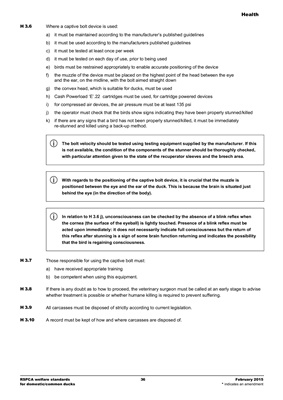
Health
RSPCA welfare standards
for domestic/common ducks
36 February 2015
* indicates an amendment
H 3.6 Where a captive bolt device is used:
a) it must be maintained according to the manufacturer's published guidelines
b) it must be used according to the manufacturers published guidelines
c) it must be tested at least once per week
d) it must be tested on each day of use, prior to being used
e) birds must be restrained appropriately to enable accurate positioning of the device
f) the muzzle of the device must be placed on the highest point of the head between the eye
and the ear, on the midline, with the bolt aimed straight down
g) the convex head, which is suitable for ducks, must be used
h) Cash Powerload 'E'.22 cartridges must be used, for cartridge powered devices
i) for compressed air devices, the air pressure must be at least 135 psi
j) the operator must check that the birds show signs indicating they have been properly stunned/killed
k) if there are any signs that a bird has not been properly stunned/killed, it must be immediately
re-stunned and killed using a back-up method.
The bolt velocity should be tested using testing equipment supplied by the manufacturer. If this
is not available, the condition of the components of the stunner should be thoroughly checked,
with particular attention given to the state of the recuperator sleeves and the breech area.
With regards to the positioning of the captive bolt device, it is crucial that the muzzle is
positioned between the eye and the ear of the duck. This is because the brain is situated just
behind the eye (in the direction of the body).
In relation to H 3.6 j), unconsciousness can be checked by the absence of a blink reflex when
the cornea (the surface of the eyeball) is lightly touched. Presence of a blink reflex must be
acted upon immediately: it does not necessarily indicate full consciousness but the return of
this reflex after stunning is a sign of some brain function returning and indicates the possibility
that the bird is regaining consciousness.
H 3.7 Those responsible for using the captive bolt must:
a) have received appropriate training
b) be competent when using this equipment.
H 3.8 If there is any doubt as to how to proceed, the veterinary surgeon must be called at an early stage to advise
whether treatment is possible or whether humane killing is required to prevent suffering.
H 3.9 All carcasses must be disposed of strictly according to current legislation.
H 3.10 A record must be kept of how and where carcasses are disposed of.